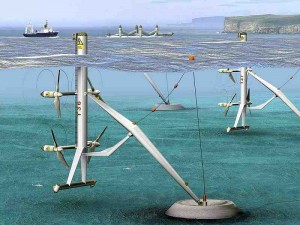Harnessing the world’s highest tides
by Tom Mason
THE WINDSWEPT TOWN OF Stromness on Scotland’s Orkney Islands was given its name by the Vikings who first settled here 1,000 years ago. It means “strong tide point,” a reference to the powerful tides that rip by the headland that lies just south of the town. Here in this out-of-the-way place the European Marine Energy Centre (EMEC) has chosen to build its test facility, a collection of offices, power substations, weather stations and observation platforms spread throughout the community. Amid the stark beauty of the Orkneys, EMEC is testing the technologies of more than 130 companies and universities from around the world – technologies designed to harness the massive hydraulic power of the oceans, and create energy from waves and tides.
Of the dozens of good ideas vying for attention at Stromness, one technology is getting more than its share of attention. If the tidal power turbine developed by Dublin-based OpenHydro Group Ltd. works the way its designers predict, it might just win the race to be the technology that mankind chooses to harness the power of the ocean’s tides.The technology is perfect for placement at tidal power points around the world, according to OpenHydro CEO James Ives. In waterways where geology, geography and hydrology combine to amplify the daily tides – the Bristol Channel in the UK, the Gulf of Saint Malo in France, the Yellow Sea, the Straits of Magellan and a dozen other locations around the world – Ives predicts that tidal electrical-generating farms powered by OpenHydro turbines will soon be an important source of electrical power. But the first place that OpenHydo plans to set up shop is at the mother of all tidal power points – the Bay of Fundy.
In 2007, OpenHydro signed an agreement with Nova Scotia Power to set up a demonstration tidal power station on the floor of the Bay of Fundy. NSP chose the technology over 20 other technology suppliers. When it comes on line, sometime in the next year, the one-megawatt facility will be the largest commercial in-stream tidal generator in the world, supplying electricity directly to Nova Scotia’s power grid. The station could be the first of a large tidal power farm that will eventually harness the full potential of the Fundy tides. “The Bay of Fundy is one of the best places for tidal power in the world,”says Ives from his Dublin office. “That’s why this contract with Nova Scotia Power is so important to us. It’s important to start small, and this provides us with the opportunity to test the technology under ideal conditions.”
One of the big appeals of OpenHydro’s technology is its low environmental footprint – a huge consideration in a place like the Bay of Fundy. The technology uses a giant subsea turbine shaped like a donut that sits unseen on the bottom of the bay to convert the flow of the tides directly into electricity. The turbine blades are internal so they don’t present a danger to sea mammals, and there are no toxic chemicals or oils contained in the system that could leak out into the environment. During the Stromness testing, the turbines have chalked up an excellent safety record, but Open Hydro is still approaching the Bay of Fundy test project with plenty of caution. “We’re not talking about going in and installing thousands of turbines along the bottom of the bay,” says Ives. “We need to go into this in a mature way. We’re going to start with a single turbine and study it carefully before we expand the operation.”
The tides of Fundy represent one of the most predicable and reliable power sources in the world, says Ives. Unlike wind and solar power, they don’t depend on weather conditions – and with hungry American markets lying on the other side of the Gulf of Maine, OpenHydro’s innovative technology could mean the start of a whole new industry for Atlantic Canada.

